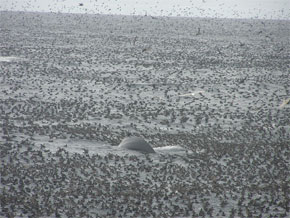

Habitat Assessment and Marine Chemistry: Nutritional Ecology
 |
A productive hotspot in Unimak Pass. |
| |
Research at the Nutritional Ecology Laboratory applies methods of
analytical biochemistry to understand the structure and function of marine food
webs. Our studies assess factors underlying energy allocation strategies and
nutritional quality of forage species using lipid class and proximate analysis.
We employ fatty acid analysis as a means of understanding patterns of energy
flow in large marine ecosystems such as the Bering Sea
and the Gulf of Alaska. Our analysis of energy phenology
and trophic linkages is aimed at
predicting the consequences of climate change on ecosystem functions.
Our work proceeds from the central idea that marine species
need to grow rapidly and store energy if they are to survive periods of
resource depletion. These needs are most acute for those organisms or life
stages that depend directly on the annual production cycle, particularly at high
latitudes. The resulting seasonal flux in energy content of species has a
profound influence on their recruitment and nutritional value to their
predators. This bioenergetic approach allows us to understand how temperature
and forage quality influence the productivity of high-latitude marine ecosystems.
Key Publications to this Research
Heintz R. A., Vollenweider J. J. (2006) Seasonal variation in energy allocation strategies of walleye pollock. October-December 2005. Quarterly Report. National Marine Fisheries Service, Alaska Fisheries Science Center, Auke Bay Laboratory, Juneau, Alaska.
Heintz R. A., Nelson B. D., Hudson J., Larsen M., Holland L., WipfliI M. (2004) Marine subsidies in freshwater: effects of salmon carcasses on lipid class and fatty acid composition of juvenile coho salmon. Transactions of the American Fisheries Society 133:559-567.
Vollenweider J. J., Womble J. N., Heintz R. A. (2006) Estimation of seasonal energy content of Steller sea lion (Eumetopias jubatus) diet. In: Trites A. W., Atkinson S. K., DeMaster D. P., Fritz L. W., Gelatt T. S., Rea L. D., Wynne K. M. (eds) Sea lions of the world. Alaska Sea Grant Colllege Program, University of Alaska Fairbanks, Fairbanks, Alaska, p 155-176
Contact
Ron Heintz
Auke Bay Laboratories
Alaska Fisheries Science Center, NOAA Fisheries
Ted Stevens Marine Research Institute
17109 Pt Lena Loop Rd
Juneau AK 99801
(907) 789-6058
Ron.Heintz@noaa.gov
|